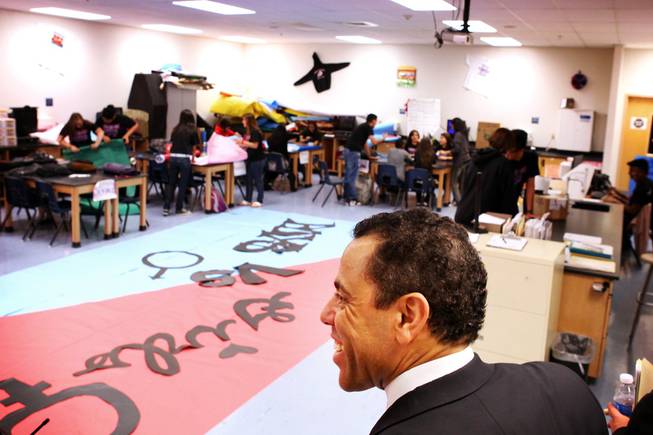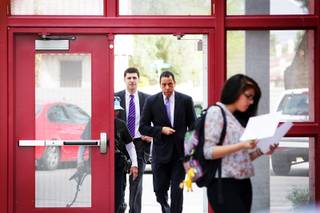
U.S. Department of Education Deputy Secretary Tony Miller tours Western High School in Las Vegas on Thursday, March 29, 2012.
Saturday, March 31, 2012 | 2 a.m.
What is a turnaround school?
The Clark County School District implemented the "turnaround" model at five of its worst-performing schools for the 2011-2012 school year. Four of these schools — Chaparral, Mojave and Western high schools, and Hancock Elementary School — received a piece of $8.7 million in federal School Improvement Grant money to improve test scores and for the high schools, graduation rates. As part of the turnaround model, the principal and at least half of the staff were replaced at each school, and schools were required to implement new programs and teaching methods to improve student achievement.
This is another in a yearlong series of stories tracking efforts by the Clark County School District to improve student performance at five struggling schools.
The government’s second-in-command for education came to town this week to nose around. The federal government has sent $8.7 million in federal money to help Clark County improve its poorest-performing schools, and Tony Miller wanted to see if it was doing any good.
He focused on Western High School, which had grown anemic in recent years, graduating only 43 percent of its students. It’s getting $2.5 million in federal aid over three years.
By the end of his visit on Thursday, he had heard an earful from students, faculty and parents — stuff of optimism and hope and how things are changing for the better.
And Miller, the deputy secretary of education, offered something of an endorsement for a job well done so far: “If we’re going to be successful ... it is going to be in an environment like Western’s.”
As schools go, Western wasn’t an easy nut to crack. It has some of the lowest test scores in the valley. More than a third of students were credit deficient, and teachers had reported upward of 2,000 disciplinary incidents after the first semester last school year.
Something had to change.
As a stipulation of the School Improvement Grant, the School District replaced half of Western’s staff, extended the school day by 20 minutes and changed the school’s curricula. The grant also outlined a series of test-score benchmarks and goals for the struggling school.
Using a combination of district funding and federal School Improvement Grant dollars, Western now has a health and technology focus and a new library, science and journalism wing. Teachers have been given signing bonuses, more student data and additional training to raise student achievement. The entire school was reorganized: There are now seven periods instead of six, and grade levels were separated on different floors of the school to improve safety and increase class spirit and school pride.
The changes were radical, the promise of change palpable.
Miller, who is second in command to Secretary of Education Arne Duncan, knows much is riding on the success or failure of the federal government’s grand experiment with public education. Since 2009, the government has poured more than $4.6 billion into the School Improvement Grant program, commonly known as the “turnaround” process, which represents one of the largest investments in public education in the nation’s history.
The money has gone to thousands of schools across the nation like Western and Clark County’s other School Improvement Grant schools: Chaparral, Mojave and Rancho high schools, and Hancock and Kit Carson elementary schools. (Elizondo Elementary School did not receive School Improvement Grant dollars but underwent a turnaround with district funding.)
Education “is critical to our economic prosperity and our national security,” Miller said. “We’re in a state of crisis. ... We need to see what’s working, why it’s working and take the lessons learned not just to other turnaround schools, but schools across the country.”
The preliminary results of the turnaround process have been mixed across the nation. In the two years since the School Improvement Grant program was launched, some schools demonstrated major gains after the first year while other schools posted marginal improvements. Some school districts just made the prescribed changes to comply with the federal grant, going through the motions of the turnaround. Other districts have fundamentally altered their entire school systems, spurring innovative solutions to America’s education woes.
Clark County has embraced the turnaround mission, district officials said. Under Superintendent Dwight Jones, the School District underwent a systemic reorganization, rolled out a new school-ranking system and instituted a new way of measuring student achievement that emphasized academic improvement instead of relying solely on proficiency levels.
It’s unknown yet if these changes will translate into better student achievement, but officials have heralded them as part of a renewed effort to change the fate of children attending public schools in Las Vegas.
Western also has embraced the turnaround process, Principal Neddy Alvarez told Miller during a school tour. The group of federal, state and district officials popped into classrooms to see how the federal money is being used.
Although the final proficiency test results and annual yearly progress designations will be announced in the coming months, Western is on its way toward meeting its School Improvement Grant goals and changing the culture of the campus, Alvarez said.
About 85 percent of seniors at Western are on track to earn diplomas. That’s a marked improvement from the 64 percent of Western seniors who earned them last year, she said.
More of Western’s freshmen, sophomores and juniors are credit sufficient now compared with this time last year, Alvarez said. The number of major disciplinary infractions has dropped 62 percent to 286 incidents, and there are 14 fewer expulsions so far this year, she added.
Miller seemed impressed by the first-year results as he sat in on a forum of school and district officials, teachers, parents and students. They testified to the power of the turnaround process at Western, saying it has “made a world of difference.”
“I’ve seen the change in kids,” said Susan Tsukamoto, a graduate advocate and former teacher at Western. “Not one of the kids has said to me, ‘I don’t like it.’”
As a graduate advocate, Tsukamoto has deployed her cellphone, Facebook and even her students to persuade at-risk and dropout students to stay in school. Despite Tsukamoto’s efforts, more than 40 seniors have transferred, withdrawn or dropped out of Western since December, a stark fact that weighs heavily on the Western alumna.
The turnaround won’t happen overnight, but in small positive increments, she said. Earlier in the week, she was able to persuade two of her students to return to school, she said, smiling. Other students are noticing the changes and are starting to change themselves, Tsukamoto added.
“They’re saying, ‘I want to add a class. If I had six classes, I can boost my (grade-point average),’” Tsukamoto said. “Now they see college as a real possibility.”
Student body President Andrew Limas commended the School District’s efforts in turning around Western. He remembered last year when he and his fellow students were upset the School District had replaced teachers and instituted a bevy of changes. Now, they’re beginning to see promise of a better Western, he said.
“I’m extremely happy it’s happening now,” Limas said. “Our teachers care about us. They’re actually waiting for you at the door before class, shaking our hands, and try to offer you help after school if you need it.”
Sustaining the improvements past the first year is of concern to Alvarez, however. It takes time for perceptions to change, for a new culture of excellence to set in at a troubled school, she said. And once the three-year grant dries up, Western will have to continue to make student gains without the additional resources.
Nationally, there have been talks of de-funding the School Improvement Grant program as skeptics of the turnaround question its effectiveness. Congress has committed $534 million to the program this fiscal year, ensuring that another wave of turnaround schools; however, the program is on thin ice, according to some observers.
That concerns Alvarez, who hopes she was able to convince Miller of the positive effects of the program at her school. Although Western still is considered an underperforming school when compared with the average Clark County school, it is making steady gains toward changing that, she said, which gives her hope.
“SIG has had a positive impact at Western,” she said. “I hope they continue to keep the turnaround. The kids deserve it. We need this.”
A fresh coat of paint and a fresh perspective are among the changes being made around Western High School.
Western is one of five turnaround schools that missed the marks set by No Child Left Behind and now faces the challenge of increasing student achievement.
The school is the third oldest in the district and its campus lies near Decatur Boulevard and Veterans Memorial Highway. The majority of students attending Western are minorities from disadvantaged homes. Western is known for having a rough past, but students are optimistic about the future of their school.
Change is apparent according to students interviewed in September.
“When I was in eighth grade, I was told I was going to get shot or stabbed when I came to Western,” said senior Kole Yanez, 17. “That might have been true 15 years ago, but now, you don’t see that here.”
Rules are tightly enforced on campus. The school keeps a strict dress code policy and cell phone use during class time is not permitted.
Halls are designated by grade level giving students a sense of ownership and community. Pride is clearly visible at pep rallies and sporting events. The newfound pride might just be he medicine needed to alleviate the 8 percent dropout rate, the highest in the district.
“It’s like building a house. You need a strong foundation,” said Neddy Alvarez, principal. “You need those strong relationships. When kids know we care about them, the learning will take place.”
- Year built:
- 1960
- Mascot:
- Warriors
- Principal (Year Hired):
- Neddy Alvarez (2008)
- Mission Statement:
- “The mission of Western High School is to promote scholarship, encourage good citizenship, and embrace our cultural diversity.”
- Enrollment:
- Approximately 2,400
- Notable alumni:
- Frank Hawkins, former NFL player
Capt. Nicole Malachowski, first female Thunderbird
Ronnie Vannucci, drummer of The Killers
Tom Collins, Clark County commissioner - School Report Card:
- 2010-2011
Compiled by Gregan Wingert



Join the Discussion:
Check this out for a full explanation of our conversion to the LiveFyre commenting system and instructions on how to sign up for an account.
Full comments policy